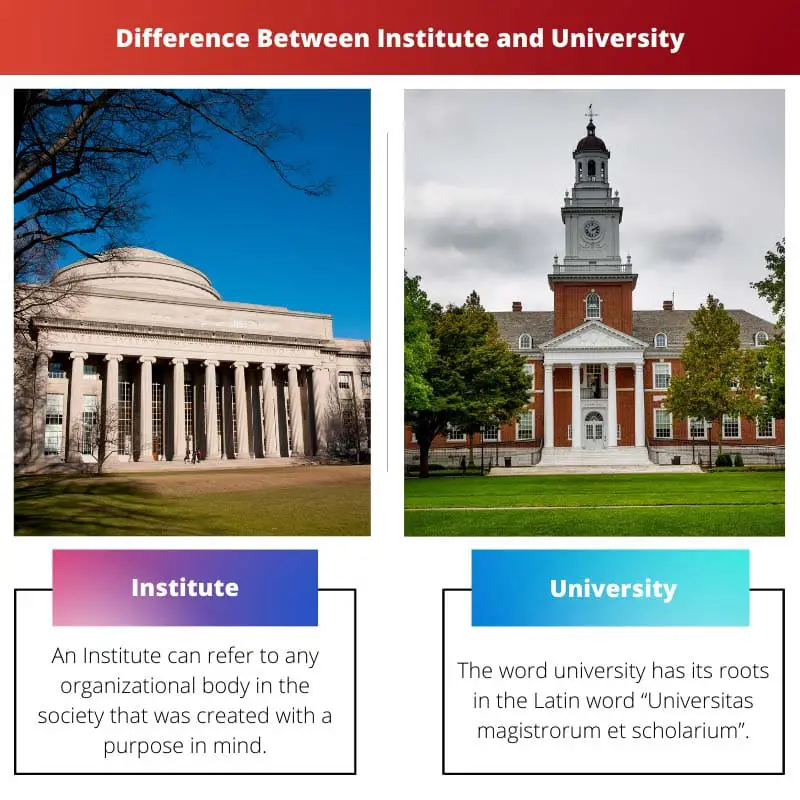Universities and institutes are the building blocks of all communities. Together they comprise all the education platforms as well as office buildings.
However, institutes and universities are confused about being the same, which does not hold in the literary sense.
Key Takeaways
- An institute is an educational organization that focuses on specialized subjects or fields, offering vocational training, certifications, or diplomas.
- A university is a higher education institution that grants degrees in various academic disciplines, comprising multiple colleges, schools, or faculties.
- The primary distinctions between an institute and a university are their size, scope, and degree offerings, with universities being larger, more comprehensive institutions that grant degrees. In contrast, institutes focus on specialized training or research.
Institute vs. University
Universities focus on higher education with the honor of graduate and post-graduate degrees. Universities give education through research-based practices, projects, assessments, etc. Institutes can offer education in any field, including business, media, etc. They mostly offer diploma degrees.

Another difference between an institute and a university is that education in an institute is focused on acquiring a specialization on industry-related topics, whereas a university focuses on research-oriented studying. Universities are for graduate and post-graduate courses, whereas institutes mostly offer diploma or specialization courses.
Universities have affiliated colleges under their belt, whereas institutes may have their franchise offering courses in different places but cannot provide degrees to students in affiliated colleges. Institutes may also include schools that provide education to children, such as primary and secondary or higher secondary schools.
Comparison Table
| Parameter of Comparison | Institute | University |
|---|---|---|
| Courses Offered | Industry-oriented | Research-oriented |
| Autonomy | Semi-autonomous | Autonomous |
| Governing Body | Board of Directors | University council |
| Funding | Most of the management money does not receive large funds, which comes from tuition fees. | Receives a large sum of money from the government because of the complexity of the types of equipment needed for research work. |
| Population | Less number of students and teachers because of the limited number of course options. | A large number of students, lecturers, professors, and researchers and various courses to choose from. |
What is Institute?
In theory, an Institute can refer to any organizational body in the society that was created with a purpose in mind. It can range from anything as small as a nuclear family to as big as a business franchise and everything in between.
However, lately, institutes are mostly regarded as educational forums related to educational or research purposes.
An institute can be governmental or non-governmental and are led by a board of directors who take charge of the management and decisions of all matter. These institutes are semi-autonomous.
The word Institute was coined from the Latin term “institutum,” which means facility or habit. An institute is part of the organizational structures of society, and looking at the functioning of an institute can help understand the functioning of the society itself.
An institute can be regarded as academic if it deals with offering degrees or conducts research-oriented work. However, institutes run autonomously and provide undergraduate or graduate degrees or offer diplomas and specializations in certain fields.
Institutes have a limited number of employees and students and have a limited number of courses to offer. They are also called academic institutes when dealing with a purely educational purpose.
However, examples of other forms of the institute are hospitals or health care institutes, military or paramilitary, corporate institutes, etc.

What is University?
The word university has its roots in the Latin word “Universitas magistrorum et scholarium,” which has the literal meaning of:
An organization of teachers and scholars
Such derivation is conceivable given that University is solely meant for higher education and research.
The origins are rooted in the medieval guilds that were organizations of teachers and students permitted by the princes and prelates. However, the world’s first University is the University of Bologna, perched in Bologna, Italy.
As academic freedom increased worldwide, the university started growing in every country. These Universities are mostly operated by Governments and are run by their funding with very minimum tuition fees charged from the students.
A university offers higher education, such as Postgraduate degrees or diplomas, and has the facilities to carry out complicated research and recruit scholars. They are not limited to one or two subjects; many courses and subjects are constantly added under their umbrella.
Due to the vast number of courses, they also recruit many employees to keep the organization running.

Main Differences Between Institute and University
- The main difference between an institute and a university is that a university is solely dedicated to higher education. In contrast, an institute can comprise an educational organization dedicated to any purpose, including business, media, fashion, etc.
- Another difference between institutes and universities is that education in institutes focuses on acquiring a specialization on industry-related topics, whereas universities focus on research-oriented studying.
- Universities are for graduate courses, post-graduate courses, and the conduction of research, whereas institutes mostly offer diploma or specialization courses.
- A University has affiliated colleges under its belt. In contrast, an institute may have a franchise offering courses in different places but cannot provide degrees to students in affiliated colleges.
- The word Institute was coined from the Latin term “institutum,” which means facility or habit. In contrast, the word university is derived from the Latin word “Universitas magistrorum et scholarium,” meaning “an organization of teachers and scholars.”




